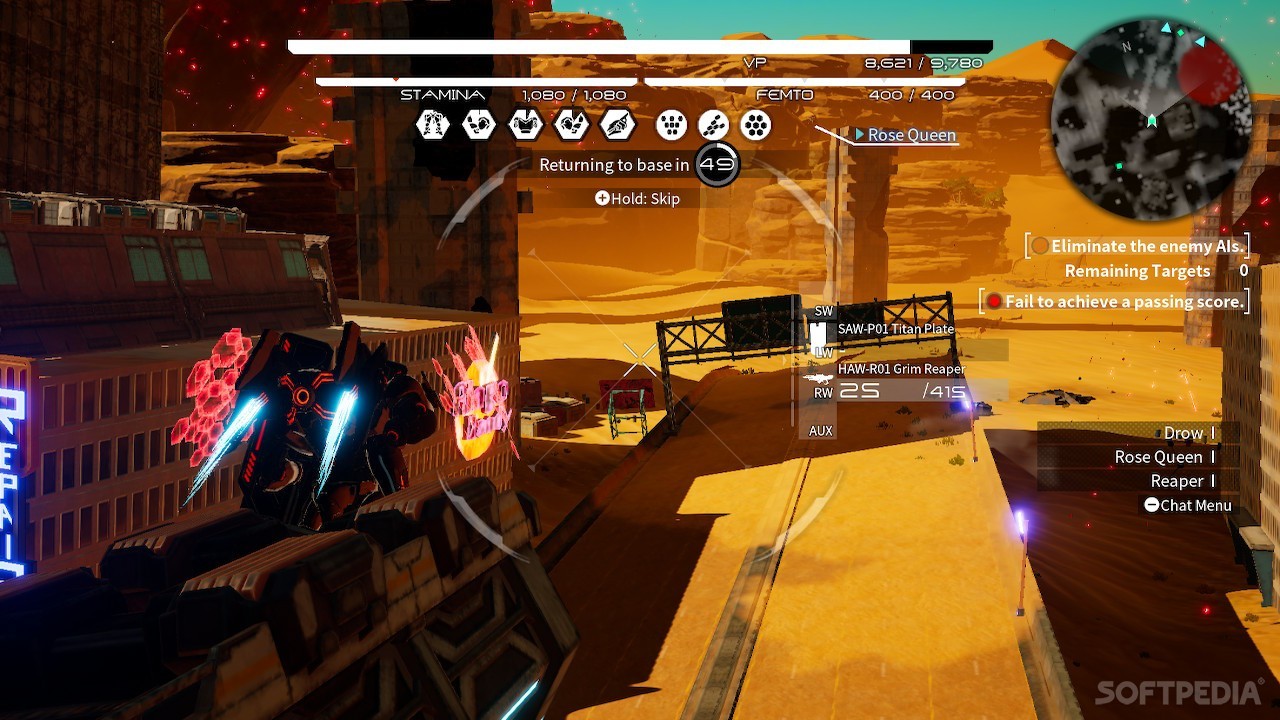
This aiming assist also goes some way to make up for the awkward feel of twin-stick controls you typically get when playing the Switch in handheld mode: since there’s no need to be absolutely spot on with your aiming, it’s far less frustrating. There’s something very gratifying about taking on a group of five or six enemies and picking them off one at a time with relative ease. Some of the self-appointed ‘hardcore’ may object to this but it does make sense: many of the game’s standard enemies are also airborne and it would be a bit odd if your extremely expensive, technically impressive giant mech struggled to accurate take down a basic flying foe.

There’s a generous aim assist in play here, meaning as long as you look in the general direction of an enemy you’ll lock onto them and start firing at them with decent accuracy. When on the ground, you’re also able to exit your mech and run around on foot, though this is rarely useful: technically it lets you continue to get involved in the action while you wait for a partner to repair your downed mech, but you’re so vulnerable in this state that it almost always results in death, at least in the early stages of the game.Ĭombat, meanwhile, is similarly satisfying. A useful dash button assigned to 'R' is an essential piece of kit, especially as the game progresses and you find yourself in increasingly larger firing lines. When you’re in the air movement is a simple case of looking in the direction you want to go and heading that way, while more extreme altitude changes can be controlled with either the 'B' button (to quickly boost upwards) or pressing in the left stick (to kill your jets and drop quickly downwards).

Mech games can be a bit of a slog to control but that isn’t the case here at all: your Arsenal (which is what the game’s mechs are called) is a breeze to commandeer, and while the hefty command list can initially seem quite daunting, it only really takes a couple of missions before you’re swooping around with all the grace of. Games like this do their talking on the battlefield, of course, and it’s here where Daemon X Machina shines for the most part. The fact that many of the cutscenes between missions simply involve different characters turning up to stand practically motionless in a room and talk to each other does nothing to help matters: even if what they’re saying is of interest, the set-up is dull as dishwater and it can be hard to keep focused.

There are just far too many active components in play here: it’s like playing chess and having the pieces swapped out for new ones every few turns. That isn’t the fault of the voice acting (which is generally of high quality) or even of the dialogue itself, which is well written. This whole idea of characters popping in and out can make it difficult to get a grasp of the plot early on, and as the storyline develops and you start getting a load of conspiracy theories and “can you trust this faction, can you trust that one, can we even trust the company we’re working for” shenanigans, it can continue to be a little tricky to stay on top of things. Accompanying you on your quests are mercenaries from other factions, who turn up and drop out depending on whether they fancy a piece of each mission. It isn’t all bad news: this radiation also increased your own abilities, meaning your fully customisable avatar has more to offer than your typical civilian.

DAEMON X MACHINA PARTS SERIES
Playing as an unnamed rookie mercenary who specialises in piloting giant mechs, your job is to take on a series of paid missions to do your bit in the war against artificial intelligence, which turned against the human race after a colliding moon sent some strange radiation across the planet. It does throw up two questions, though: exactly how much has it improved, and is it too late to get back those who were disillusioned by that extremely early demo? We can’t answer the latter – only time and the charts will tell – but we can at least confirm that the finished game is a solid piece of work, even if it isn’t quite an absolutely essential one.
DAEMON X MACHINA PARTS HOW TO
After developer Marvelous released a demo way back in February and explained that it wanted feedback on how to improve the game, a number of players instead interpreted it as a product that was close to completion, and so decided that because it was a bit on the shonky side they weren’t going to buy it.įast forward seven months and it’s fair to say that Marvelous was absolutely right: Daemon X Machina has certainly improved in numerous ways thanks to user feedback. This is something the team behind Daemon X Machina may end up learning when the game releases this week. While it’s always a good idea to ask for help when you feel like you might need it, it doesn’t always benefit you in the long run.


 0 kommentar(er)
0 kommentar(er)
